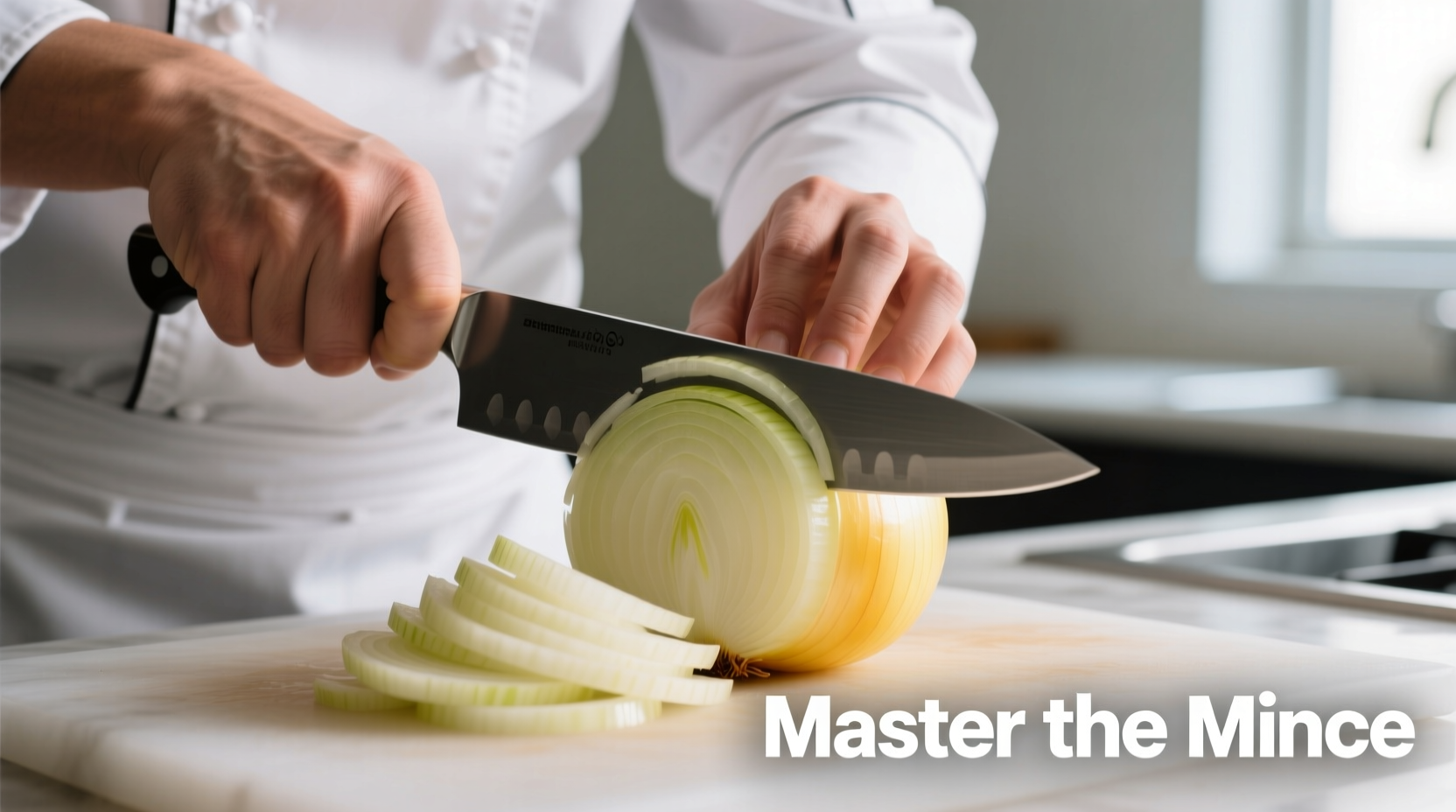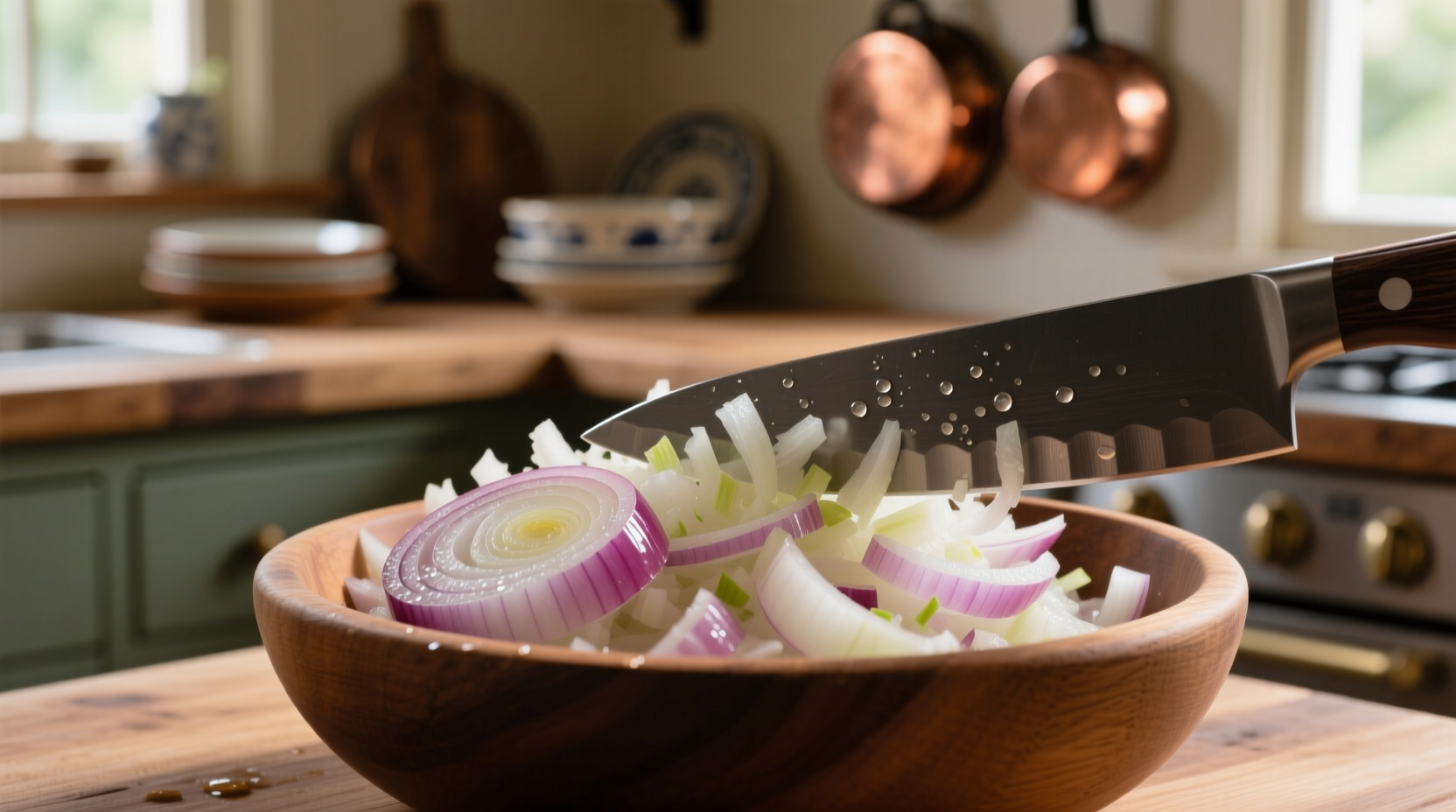The most efficient way to mince an onion is by using a chef's knife with a curved blade, starting with quartering the onion, making parallel vertical cuts toward (but not through) the root end, then horizontal cuts before slicing downward in a rocking motion. This technique creates uniformly small pieces (1-2mm) that release maximum flavor while minimizing tears when done properly.
Whether you're preparing a sofrito, making homemade salsa, or building flavor foundations for soups and stews, properly minced onions make a significant difference in your cooking. As a professional chef with years of kitchen experience, I've found that mastering this fundamental technique separates adequate home cooks from truly skilled ones. The right mincing method ensures even cooking, optimal flavor distribution, and prevents those frustrating large chunks that remain raw while the rest of your dish is perfectly cooked.
Why Proper Onion Mincing Matters
When onions are correctly minced, their cell structure breaks down sufficiently to release maximum flavor compounds while maintaining enough texture to contribute to your dish. Unlike rough chopping where larger pieces might cook unevenly, finely minced onions distribute their sweetness and pungency uniformly throughout your recipe. This is particularly crucial for dishes where onions form the flavor base, such as French mirepoix, Italian soffritto, or Spanish sofrito.

Step-by-Step Mincing Technique
Follow these professional steps for perfect minced onions every time:
- Preparation: Chill onions for 30 minutes before cutting—this reduces the enzyme reaction that causes tears. Peel the onion and cut off both ends, then slice in half through the root.
- Quartering: Place each half flat-side down and slice vertically from stem to root, creating quarters while keeping the root end intact (this holds the layers together).
- Vertical Cuts: Make thin parallel cuts toward the root end without slicing all the way through—this creates the foundation for fine mincing.
- Horizontal Cuts: Angle your knife and make 1-2 horizontal cuts through the onion layers.
- Rocking Motion: Hold the tip of your knife down with one hand while using a rocking motion with the other to slice downward through all previous cuts.
- Final Chop: Gather the minced pieces and give them a few final chops if needed for uniformity.
Common Mincing Mistakes to Avoid
Many home cooks struggle with onion preparation due to these common errors:
- Using the wrong knife—a small paring knife requires more cuts and increases tear risk
- Cutting through the root end—this causes layers to separate, making controlled mincing difficult
- Rushing the process—taking time with proper technique yields better results than hurried chopping
- Incorrect hand positioning—using the "claw grip" protects fingers while maintaining control
| Cutting Technique | Size | Best For | Flavor Release |
|---|---|---|---|
| Mincing | 1-2mm | Sauces, dressings, meat fillings | Maximum—fully integrates flavor |
| Dicing | 3-6mm | Salsas, stir-fries, salads | Moderate—distinct pieces remain |
| Chopping | 6-10mm | Stews, roasts, chunky salsas | Minimal—pieces retain structure |
Managing Onion Tears: Science-Based Solutions
When you cut an onion, you break cells containing enzymes and sulfur compounds that combine to form syn-propanethial-S-oxide—a volatile gas that irritates eyes. Professional kitchens use several evidence-based methods to minimize this reaction:
- Cut near running water or under a gentle stream—water molecules bind to the volatile compounds
- Use a sharp knife—cleaner cuts cause less cell damage and reduce gas release
- Cut the root end last—the highest concentration of enzymes is in the root
- Work in a well-ventilated area or use a fan to direct gases away from your face
According to research from the USDA Agricultural Research Service, chilling onions before cutting reduces the volatility of the irritating compounds by approximately 30%, making this one of the most effective home kitchen techniques.
When to Mince vs. Other Cuts
Understanding culinary context determines whether mincing is appropriate for your dish:
- Always mince for sauces where you want onions to completely dissolve into the base (tomato sauce, béchamel)
- Minced is best for meat mixtures where uniform flavor distribution is crucial (meatloaf, burgers, meatballs)
- Dice instead when you want visible onion pieces that maintain texture (salsas, stir-fries, salads)
- Chop coarsely for dishes where onions will cook for extended periods (stews, braises, roasts)
Advanced Mincing Techniques
Professional chefs employ these refined methods for specific applications:
- For maximum flavor extraction: After mincing, sprinkle with a pinch of salt and let sit for 5 minutes before cooking—this draws out moisture and concentrates flavor
- For raw applications (salsas, pico de gallo): Rinse minced onions briefly in cold water to reduce sharpness while preserving texture
- For extended storage: Toss minced onions with a teaspoon of vinegar per cup—this preserves color and texture for up to 3 days refrigerated
Food science research from University of Minnesota Extension confirms that properly stored minced onions maintain 90% of their nutritional value for 2-3 days when kept in airtight containers with minimal air exposure.
Special Considerations for Different Onion Varieties
Not all onions mince the same way due to varying water content and cell structure:
- Yellow onions (most common for cooking): Ideal for mincing as they caramelize beautifully and have balanced pungency
- Red onions: More water content means they release more liquid when minced—best rinsed for raw applications
- White onions: Firmer texture holds shape better when minced for cooked dishes
- Shallots: More delicate—use a gentler mincing technique to prevent mushiness
Storing Minced Onions Properly
Proper storage maintains quality and prevents spoilage:
- Place in airtight container with minimal air space
- Press plastic wrap directly onto the surface to prevent oxidation
- Refrigerate for up to 3 days (longer storage causes flavor degradation)
- For longer storage, freeze in ice cube trays covered with water—thaw as needed
FAQ: Frequently Asked Questions
How fine should minced onions be?
Properly minced onions should measure 1-2 millimeters in size—small enough to distribute evenly but not so fine that they become mushy. When spread on a cutting board, they should resemble coarse sand rather than a paste.
Why do my minced onions become watery?
Onions naturally contain 89% water. When minced, cell walls break and release moisture. To reduce excess liquid, salt minced onions lightly and let them sit for 5 minutes before patting dry with paper towels—this draws out excess moisture without compromising flavor.
Can I use a food processor to mince onions?
While possible, food processors often over-process onions into a mushy consistency. If using one, pulse in very short bursts with chilled blades and onion pieces, and immediately remove from the processor. A sharp knife provides better control for proper mincing texture.
What's the difference between minced and diced onions?
Minced onions are significantly smaller (1-2mm) than diced onions (3-6mm). Mincing creates pieces that virtually disappear into dishes, distributing flavor throughout, while dicing maintains visible pieces that retain their shape during cooking. The cutting technique differs—mincing requires more precise, closer cuts.











 浙公网安备
33010002000092号
浙公网安备
33010002000092号 浙B2-20120091-4
浙B2-20120091-4